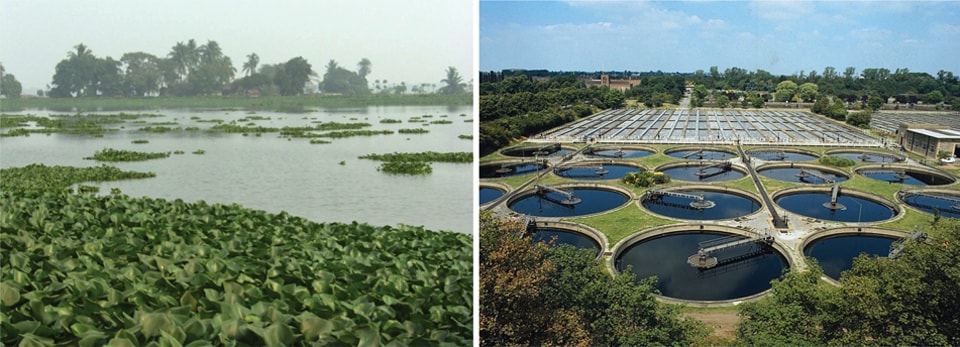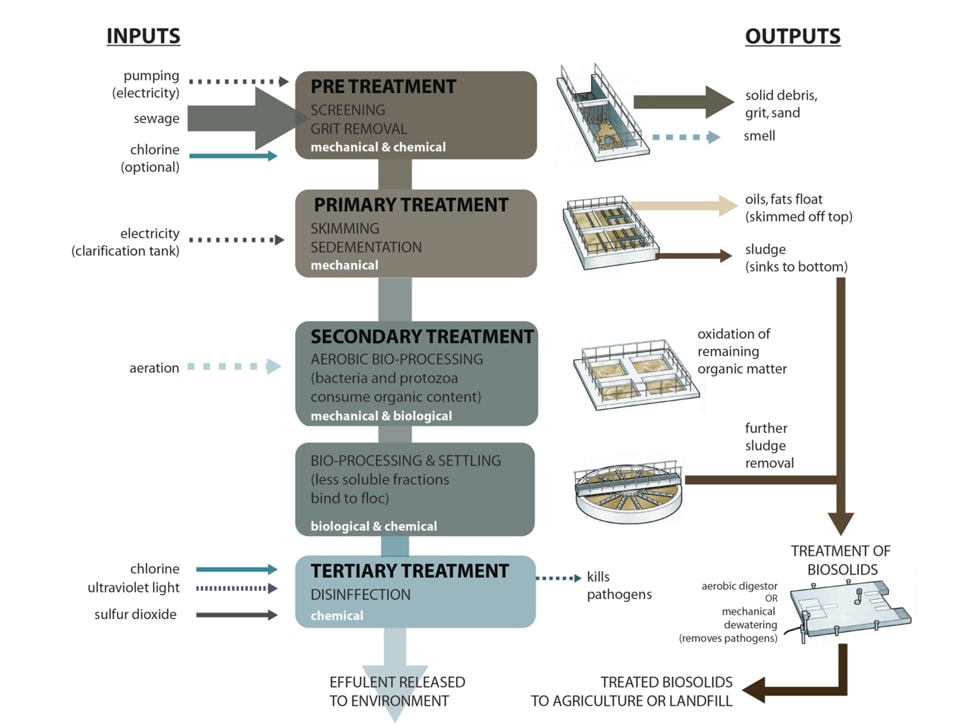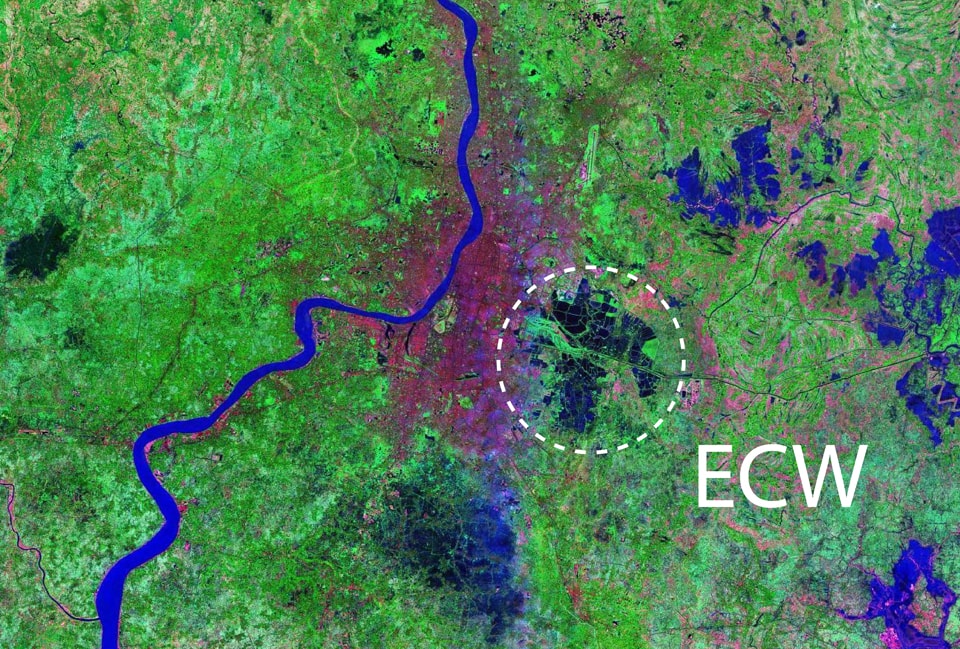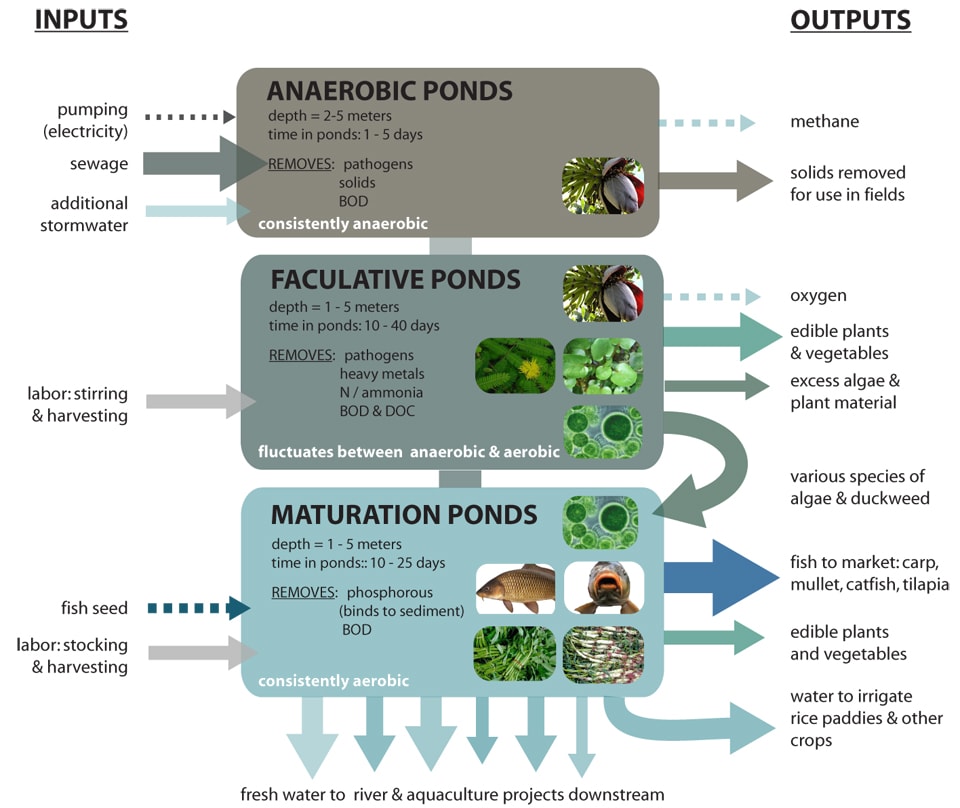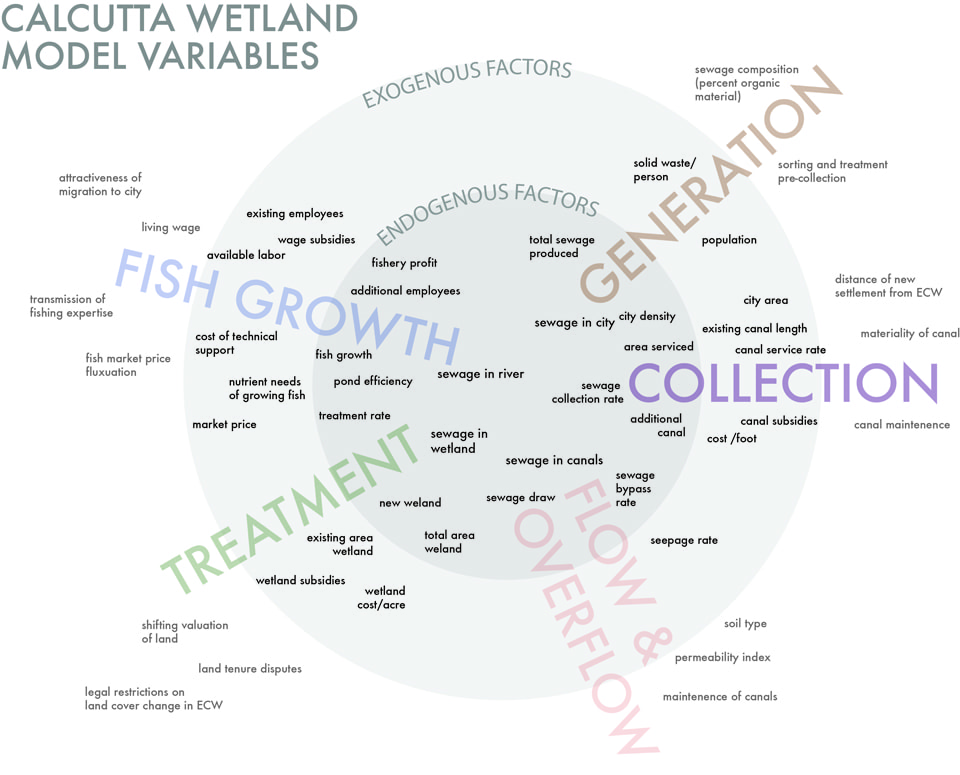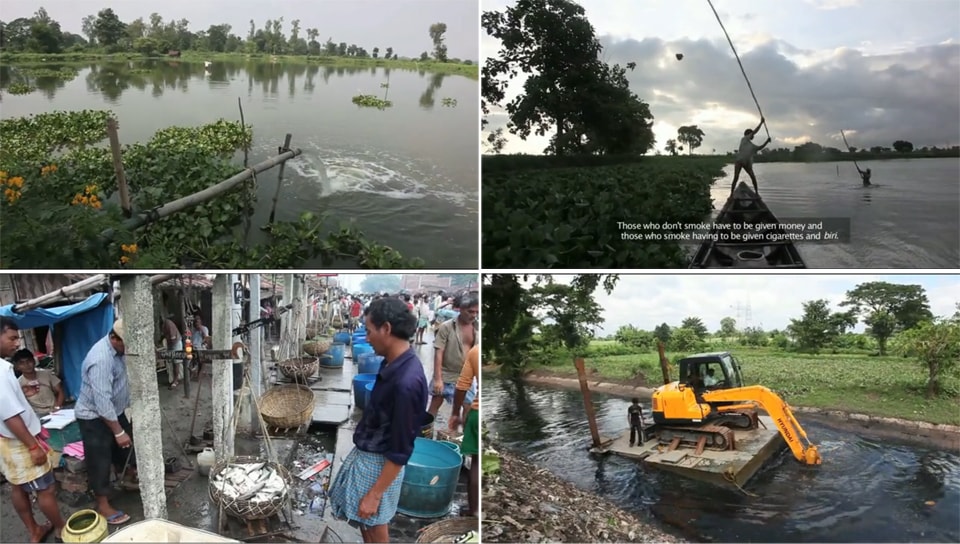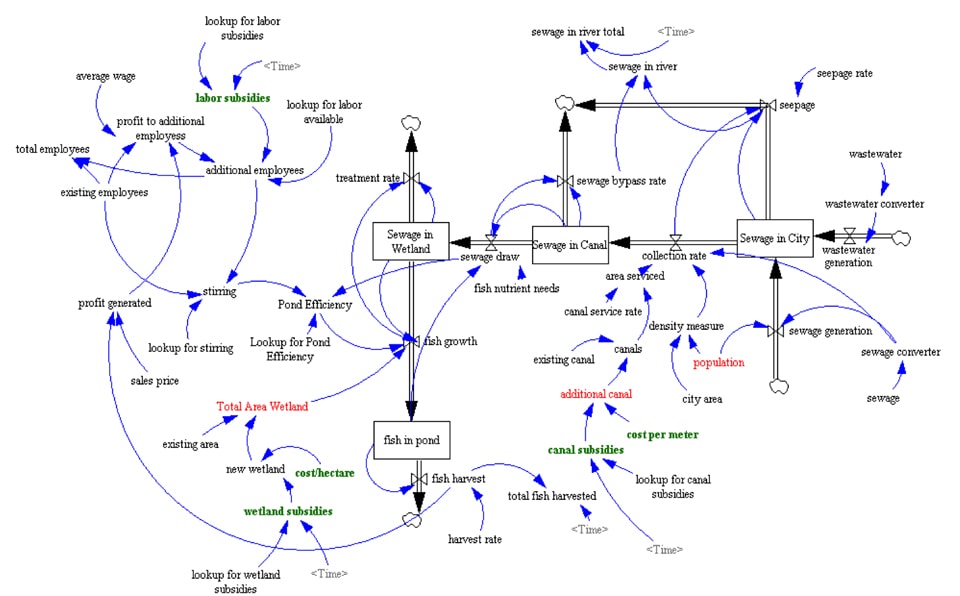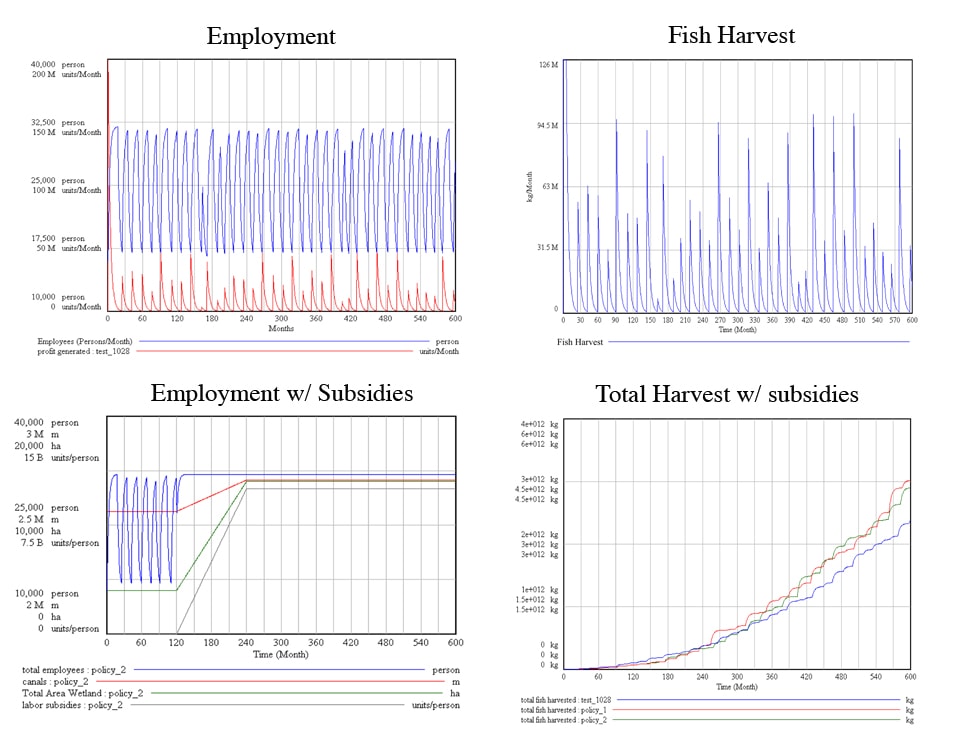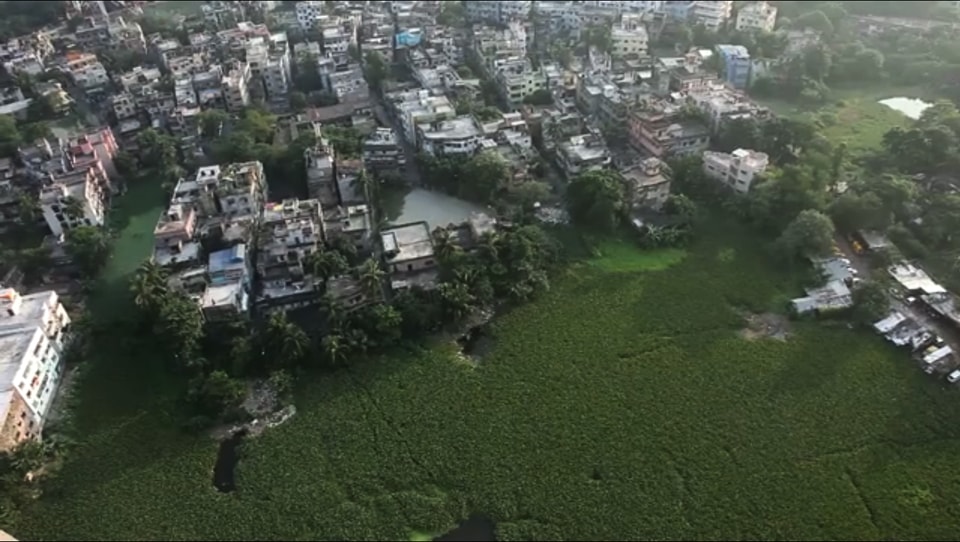Resilient, adaptive infrastructure cannot be built. It grows slowly but extensively, building up relationships in steps and bounds, integrating into surrounding systems, flows and entities; it evolves and shifts till it is essential and invisible. With urban populations growing worldwide, particularly in the developing world, there is an increased interest in green infrastructure and productive landscapes capable of operating at an urban scale, potentially growing in scale and capacity in step with the populations they aim to support. While the emotional lure of turning wholesale to “natural systems” to meet our infrastructural needs is incredibly appealing, and the ease of placing landscape features in renderings and design imagery, there are significant challenges involved in employing green infrastructure at a scale that meets present and future needs. This paper presents the case study of a remarkable example of living systems infrastructure, the East Calcutta Wetland, a high-performance, engineered and managed ecological system that has developed over a century to treat urban waste, produce saleable fish and vegetables, create employment and support a local population and economy.
The value and complexity of the wetland cannot be captured by photographs or simple narrative prose. In order to learn from this example, as designers, engineers or policy-makers, it may be necessary adopt a new lens for approaching infrastructural systems that allows designers to move beyond mere outward appearance and form of infrastructural objects, to approach complex systems through an understanding of their essential behavior and the relationships upon which performance is achieved.
Figure 1 East Calcutta Wetland, an example of living systems infrastructure tightly bound to urban fabric and performance. Image from Google Earth
Living Systems Infrastructure and Urban Ecology
Living systems infrastructure utilizes landscape systems to perform ecosystem services (treating stormwater, increasing air quality, treating or processing waste, sequestering carbon, producing energy and nutrients), taking advantage of synergistic relationships between system components and functions [1]. In the urban environment, the performance requirements and constraints placed on infrastructure can rarely be met with truly natural, or unmediated systems. Living systems infrastructure presents a model of thinking and designing hybrid, high performance systems which use an ecosystem ecology perspective to construct and manage environments.
In order for living systems infrastructure to be a viable alternative or supplement to traditional modes of fixed, “grey” infrastructure, there must be a clear, and robust method for assessing the performance of these systems. As much as we may wish it otherwise, the challenge of measurement may very well be the largest impediment to utilizing living systems or green infrastructure at a meaningful scale. It will likely always be easier to predict the future performance of a mechanical system than a biological system. It is easier to accurately predict the flow rate of a culvert than a river; it is easier to assure the sewage treatment capacity of an activated sludge plant than a constructed wetland. Our ability to understand these systems, our ability to describe them and draw them, is crucial to our ability to see them as meaningful strategies and within the realm of design possibilities.
Bringing environmental engineering and environmental management to urban landscapes in a large scale and distributed manner is not just a question of assuring design quality and performance, it also causes us to reconsider the idea of the city, the functioning of its essential building blocks and the relationships of urban components – be they constructed or natural, social, economic or environmental.
Urban Ecology; Unpacking the City
Living systems infrastructures are not merely “soft” or “resilient” machines as popularly hypothesized in architectural circles [2,3,4]. Rather, they are better described as engineered ecosystems. Ecosystems ecology is a useful method for studying the urban environment and for managing resources as it calls attention to the relationships which link biotic systems and the physical systems on which they depend [5]. Infrastructural systems of a variety of forms and constructions can be described through the material and energy flows that are essential to their function. This framework allows us to compare both “constructed” and “natural” systems – breaking each down into their constituent parts and their relational logic in order to understand their performance or layered functions be they economic, environmental or social [6].
Figure 2 Treatment wetland, Image by South Asian Forum for the Environment (SAFE) [left] Sewage treatment plant. Image by ABCTechnolab [right]
For the most part, recent green infrastructure projects in American cities have focused primarily on stormwater management [7]. However, living systems are capable of performing a much wider range of ecosystem services currently covered by pieces of civil and environmental engineering. Sewage treatment is an interesting example of one such service, as it is a process that is for the most part, hidden from sight. Conventional sewage treatment plants are so ubiquitous in the United States that we take this expensive, but essential service for granted. However, even the most highly engineered sewage treatment plant utilizes a combination of biological, chemical and mechanical processes.
Architecturally, we might be compelled to describe wastewater treatment as an assemblage of infrastructural objects: holding tanks, settlers, skimmers, bioreactors, etc. An ecologist, by contrast, might approach the task of describing conventional wastewater treatment by focusing on the flows of energy and materials across the system, describing inputs, ecosystem processes and the resulting outputs. While a plan or section may be best suited for describing the placement of objects in a landscape, a process diagram can capture relationships and actions over time. In the diagram below, we see the stages of wastewater treatment described through their inputs (sewage, water, air, electricity, ultraviolet light, chemicals), the processes undergone (screening, skimming, settling, bioprocessing) and outputs (grit, sand, biosolids, oils, sludge, smell, clean water).
Figure 3 Conventional sewage treatment as a system of processes and components. Image by Stephanie Carlisle
Conventional sewage treatment plants already integrate biological processes in a controlled environment. A treatment wetland also does so while allowing the landscape to perform a variety of additional services unimaginable in a wastewater treatment plant. Rather than seeing these systems in clear opposition, understanding the relationships between “green” and “grey” infrastructure is essential for proposing viable alternatives that can credibly take on the roles currently held by conventional infrastructural systems.
The East Calcutta Wetland
In Calcutta, West Bengal, a series of canals collects the city’s sewage and channels it into one of the largest and most productive aquaculture systems in the world – producing nearly 100 million pounds of saleable fish per day, fertilizing thousands of hectares of farmland and creating as many as 40,000 jobs [8,9]. Since the East Calcutta Wetland remains the only sewage treatment option for the metropolis, any sewage that remains uncollected eventually finds its way into the already polluted Hooghly River and eventually into the Bay of Bengal. The scale of the ECW in terms of land mass and urban impact is massive – the wetland is composed of over 150 fisheries which cover 3,000 hectares of land (7,500 acres), process 550,000 cubic meters (145 million gallons) of raw sewage and storm water every day, and produce roughly sixteen percent of the city’s fish sales [10]. In doing so, the ECW is more than just a wastewater treatment plant or a treatment wetland; it provides for the four critical needs of developing countries: food, sanitation, water and livelihood.
Figure 4 Landsat imagery of Calcutta metropolitan area with the ECW called out in the southeastern area of the city.
In a region where building and maintaining conventional waste water treatment plants has proved untenable from a financial and political standpoint, [11] the wetland has emerged as a robust piece of the city’s infrastructure since its initial construction over a hundred years ago. In addition, the wetland provides a range of non-monetized ecosystem services including control of water and air pollution, groundwater recharge and flood control, preservation of biodiversity and habitat, and improved living standards of local residents.
However, despite its benefits, the wetland and the community that manages it have been consistently under appreciated and remain under continuous threat of encroachment from development [12]. Additionally, due to a deficiency of city planning and infrastructure management, the majority of the city’s population remains underserved, lacking access to adequate sanitation and creating a state of acute public and environmental distress. Since the 1970s, researchers have studied the ECW, each addressing the specific concerns of water quality, social justice and labor, ecosystem health and functioning, regional fish markets and land tenure law [13]. Few of these papers referenced each other and none took a perspective holistic enough to describe the urbanistic functioning of the system or project its future prospects. Several new wetlands have been created as engineering experiments, and while there have been some successes, none of which have been able to meet or exceed the performance of the East Calcutta Wetland.
Growing Infrastructures
The ECW is an important case study, not only for its present conditions, but also for the linkages between its development and the growth of Calcutta. The ECW is an entirely constructed system, sited on land previously occupied by a brackish estuary that was deprived of its water source when the River Bidyadhari lost its flow. The founding of the wetland is hard to pin down precisely, but began shortly after the city abandoned the practice of channeling its sewage uphill towards the Hooghli River and began building canals that brought effluent, stormwater and solid waste eastward toward the Kulti Gong River and the swampy estuary that formed the eastern and southern edge of the city [14, 15]. That same estuary had been the site of local aquaculture practice since the 1850s, drawing water from the Bidyadhari River. Just as the Bidyadhari lost its flow and was declared “dead” by the Irrigation Department of Bengal, local fishermen, faced with the challenge of keeping their aquaculture ponds alive despite the loss of both water and nutrients, recast the waste stream as a valuable feedstock. As soon as the following year, there is evidence that the fishermen in the immediate area had begun siphoning sewage and storm water runoff and using it to fertilize their ponds [16, 17, 18].
Figure 5 Major hydrological flows showing movement of stormwater and sewage from initial collection across metropolitan Calcutta into the either the Hoogli River or into the East Calcutta Wetlands for treatment. Image by Stephanie Carlisle
Use of wastewater continued in an uneven and illicit manner until the 1940s, when the engineers from the Calcutta Corporation completed the Kulti Outfall Scheme, which increased the capacity of the city’s drainage channels, installed pumps, sedimentation tanks and raised the level of sewage heads to support adequate flow to most of the fishponds by gravity [19, 20]. From this point forward, the wetland and the city’s drainage and waste system were inseparable, each thriving from the byproducts of the other [21, 22].
The city and the wetland have continued to grow into one another to the extent that they can no longer be pulled apart. Not only is the wetland the result of the flow of sewage, stormwater and waste, it also relies upon social and economic exchanges to support its growth. The resulting landscape is a heterogeneous patchwork of managed conditions marked by wet and dry land, sites of production, maintenance, habitation, transportation and cultivation that forms a gradient from the dense urban edge to the agricultural hinterland.
Figure 6 Flows of energy and material in and out of the East Calcutta Wetland. Image by Stephanie Carlisle
Within the wetland’s ponds, sewage is treated in a series of contained pools with carefully managed conditions and residence time [23]. As nutrient-rich effluent moves through the system, it is progressively cleaned, redirecting nutrients to the growth of algae or to agricultural products grown along the pond edges. Solids are removed, composted and used to fertilize surrounding fields. Algae and other aquatic plant material is used to feed several species of fish who in turn create nitrogen- and phosphorus-rich water which can be used to irrigate adjacent rice paddies [24]. While aquaculture can be described as a biological system, the wetland cannot function without additional inputs of fish seed, electricity, labor and a constant stream of wastewater and stormwater.
There are few completely “closed loop systems” in the urban environment. While living systems infrastructure may be efficiently designed and work to minimize waste through connected nutrient and energy flows, it often relies on inputs from the outside environment and in turn affects its surroundings. The East Calcutta is a leaky model. Aside from producing clean water that can be released into the river downstream, the wetland also sends produce and fish to market, income to local communities [25], visual respite to surrounding areas, and small amounts of methane into the atmosphere. These variables are no less vital to the wetland’s function than the steady flow of sewage.
Figure 7 Facultative [left] and Maturation ponds [right] share responsibility for converting sewage into nutrients and raising fish. Images by South Asian Forum for the Environment (SAFE)
Testing Dynamic Equilibrium
This narrative approach to explaining the evolution of the ECW is useful for locating the system in a historic and spatial context. However, we understand that the ECW is a complex, dynamic system, and efforts to freeze and analyze the system in a static state obscure the wetland’s continuous fluctuations and balancing mechanisms. In order to make use of this case study and establish transferable design potential of the system, it is important to break out of the view of the ECW as a fixed entity. In order to argue for the ECW as a type of living systems infrastructure that can be managed or replicated, it is essential to develop a detailed understanding of how the system functions, how it has changed over time in response to nearly a century of urban transformation, and how it will weather future shocks and stress.
Figure 7 Modeled variables driving system behavior. Diagram by Stephanie Carlisle and Thomas Chase
In living systems, nested feedback loops, time delays and non-linear relationships between seemingly disconnected system elements can make it difficult to predict behavioral change. System dynamics modeling is an approach to understanding the behavior of complex systems through the progressive building up of relationships between variables and entities of the larger complex whole. Since the East Calcutta Wetland is a system that must remain at balance in a state far from equilibrium, policies seeking to increase the efficiency of the total system must take into account sensitive dynamics or risk driving the system into collapse. In other cases, the system is resilient enough to self-correct. For example, if sewage collection is dramatically increased across the city without also increasing the capacity of wetland, that excess sewage will not be drawn into the wetland and will still end up in the river.
Another more complex series of causalities contains both balancing and reinforcing feedback loops. For example, the variables of labor, profit, treatment capacity and real estate are woven together so that as the number of fish in the ponds increases, we see an increase in profit at the market which in turn produces an increase in capital available for paying laborers, which increases the number of employees. Since employees spend much of their time stirring the treatment ponds in order to increase oxygenation, this labor leads to an increase in pond efficiency which further increases yield. However, as the treatment rate of the system increases, less money may be available for land acquisition subsidies from the government. If land subsidies decrease, new wetland area may decrease, leading to a slowing of the rate of increase in the fish yield.
Figure 8 Development pressure and labor dynamics are inseparable from the functioning of the ECW as an infrastructural system. Video stills from “East Kolkata Wetlands: Bheri Owner’s Perspective,” a documentary created by students at Jadavpur University, directed by Souvik Lal Chakraborty & Malancha Dasgupta
By identifying such interconnected, causal variables (Figure 7), and building them into a series of dynamic systems models, it is possible to simulate the functioning of the aquaculture system and explore the dynamic relationships and behaviors of key variables, allowing us to better understand the nested biological, social and development forces driving the performance of the ECW. Shown below is the structure of one of the final models exploring the effects of government subsidies seeking increase the systems capacity in light of Calcutta’s rapidly growing population.
Figure 9 East Calcutta Wetland Model: linked biological, social and development variables, modeled in Vensim. Model by Stephanie Carlisle and Thomas Chase
This model looks at variables and dynamics associated with the basic functioning of the wetland (the conversion of sewage to fish) and seeks to better understand the interconnection between pond efficiency, labor and urban context. The model sets a goal of increasing the amount of sewage that is collected in the city while creating increased, stable employment for ECW residents and decreasing the total amount of untreated sewage entering the river [26]. The model includes three main policy variables: labor subsidies, land acquisition subsidies and canal construction subsidies [21].
Our model runs indicate that increasing the amount of sewage collected in the city, and preventing it from directly entering the river is a positive move so long as that sewage can be treated by the wetland. The coupling of canal construction with wetland subsidies to increase water treatment capacity is a necessary action to meet that goal.
We also see from the policy scenarios that labor subsidies may not play a significant role in increasing total fish harvest. However, through staggered harvesting and a restructuring of labor throughout the wetland, a phase shift can be achieved that creates the possibility for full-time employment, rather than relying on temporary contracts tied to infrequent harvests. While this adjustment would not increase production or total profit, it would have a significant effect on the security and quality of life for ECW residents.
Figure 10 Model runs showing typical harvest cycles [upper right] and seasonal employment patterns [upper left], used to establish reference flows and validate model structure. At bottom, model runs showing results of policy scenarios in which seasonal employment is transformed into steady, full time employment [bottom left] and fish total fish harvest is increased slightly [bottom right] Model by Stephanie Carlisle and Thomas Chase
While it is impossible to capture every facet of a complex system, a systems model can allow the designer to test out her understanding of a system by simulating behavior, building up relationships and key variables using known data until the model progressively comes into focus through an iterative design process. Once the model is robust enough to simulate previous measured behavior and to explain expected performance such as known biological or market cycles, it may be used to simulate and test future scenarios.
Figure 11 Encroachment by development. Video still from “East Kolkata Wetlands: Ecologist’s Perspective,” a documentary created by students at Jadavpur University, directed by Mukulika Dattagupta & Tulika Bhattacharya
Infrastructural urbanism maintains that the ability for cities to grow into vibrant, healthy and beautiful spaces over time rests principally on the underlying mechanisms that drive urban form – be they technical, institutional or environmental. This stance represents a shift from an object-based to a systems-based design approach, which sees the city as a structure for possibilities rather than a fixed architectural image.
Living systems infrastructure has the potential to serve the needs of many while providing a portfolio of options that, through their flexibility, pave the way for sustainable cities. Rapidly deployed, low-tech sanitation and water management systems in peri-urban areas are just one such example of adaptable infrastructure. As designers, we should extend our field of view to include not only the material manifestations of infrastructure, but also the underlying networks of energy, material, capital, social ties, and influence that collectively steer the development trajectories of cities.
Acknowledgements
The dynamic systems model and initial case study research was produced by Stephanie Carlisle and Thomas Chase at the Yale School of Forestry and Environmental Studies.

Stephanie Carlisle is a designer and environmental researcher whose work focuses on the relationship between the built and natural environment. She works in the research group at KieranTimberlake Architects. She is a co-editor of this issue. Read her complete bio here.
References
[1] Robert Costanza, Ralph d’Arge, Rudolf De Groot, Stephen Farber, Monica Grasso, Bruce Hannon, Karin Limburg et al. “The value of the world’s ecosystem services and natural capital.” Nature 387, no. 6630 (1997): 253-260.
[2] Neeraj Bhatia and Lola Sheppard ed. Bracket “Goes Soft.” (Barcelona, Actar, 2012).
[3] Nicholas Nagroponte, Soft Architecture Machines (Cambridge: MIT Press, 1975).
[4] Sanford Kwinter, “Soft Systems,” in Culture Lab, ed. Brian Boigon (New York: Princeton Architectural Press, 1993).
[5] F. Stuart Chapin, Pamela Matson and Harold Mooney, Principles of Terrestrial Ecosystems Ecology (New York: Springer, 2002).
[6] Stewart Pickett et al., “Urban Ecological Systems: Scientific foundations and a decade of progress,” Journal of Environmental Management 92 (2011): 331 – 362.
[7] Some outlying green infrastructure programs in the US have begun to address longer-term processes such as carbon sequestration or habitat creation.
[8] Dhrubajyoti Ghosh, “Waste Water Utilization in East Calcutta Wetlands From Local Practice to Sustainable Option,” eSS Occasional Papers. 1(1) (2008): 36-56.
[9] B. B. Jana, “Sewage-fed aquaculture: The Calcutta model.” Ecological Engineering 11 (1998): 73-85.
[10]Dr. Stewart Bunting, N Kundu, and M Mukherjee. “Literature Review: Renewable natural resource-use in livlihoods at the Calcutta peri-urban interface: literature review.” (Working Paper, University of Stirling, UK Institute of Aquaculture, January 2002).
[11] Dhrubajyoti Ghosh, “Wastewater-fed Aquaculture in the Wetlands of Calcutta – an Overview.” Institute of Wetlands Management and Ecological Design, Proceedings of the International Seminar on Wastewater Reclamation and Reuse for Aquaculture, Calcutta India, 6-9 December 1988.
[12] D Mukhil, “Saving Calcutta’s Wetlands,” Economics and Political Weekly, 28 (49) (1993) 2642
[13] In the early 1980s, the first research and published scholarly work on the ECW was begun by Dhrubajyoti Ghosh, a civil engineer who would make his career studying and advocating for strategic protection of the ECW. We authored the first official report on the ECW, commissioned by the Department of Fisheries in 1983 and he also founded the Institute of Wetlands Management and Ecological Design (IWMED) in Calcutta in 1986. The IWMED remains active and under control of the State of West Bengal and is responsible for mapping, surveying and monitoring the functioning of the wetlands in and around Calcutta.
[14] Hans Dembowski, “Courts, Civil Society and Public Sphere: Environmental Litigation in Calcutta.” Economic and Political Weekly, 34(1/2) (January 2-5, 1999):49-56.
[15] Hans Dembowski, Taking the State to Court (New Delhi and Oxford: Oxford University Press, 2000).
[16] Dhrubajyoti Ghosh, “Waste Water Utilization in East Calcutta Wetlands from Local Practice to Sustainable Option,” eSS Occasional Papers 1(1) (2008): 36-56.
[17] Dhrubajyoti Ghosh and S. Sen, “Ecological history of Calcutta’s wetland conversion,” Environmental Conservation 14(3) (1987):219-226
[18] Hans Dembowski, Taking the State to Court (New Delhi and Oxford: Oxford University Press, 2000).
[19] Dhrubajyoti Ghosh, “Wastewater-fed Aquaculture in the Wetlands of Calcutta – an Overview.” Institute of Wetlands Management and Ecological Design, Proceedings of the International Seminar on Wastewater Reclamation and Reuse for Aquaculture, Calcutta India, 6-9 December 1988.
[20] Goutam Mukherjee, “Wetland Management in the Context of Regional Planning, East Calcutta—A Case Study,”Hydrological Processes and Water Management in Urban Areas (Proceedings of the Duisburg Symposium, April 1988)
[21] Hans Dembowski, Taking the State to Court (New Delhi and Oxford: Oxford University Press, 2000).
[22] Dhrubajyoti Ghosh and S. Sen, “Ecological History of Calcutta’s Wetland Conversion,” Environmental Conservation 14(3): 219-226
[23] Peter Edwards and Banco Mundial, Reuse of Human Wastes in Aquaculture: A Technical Review (Washington DC: UNDP – World Bank, Water and Sanitation Program, 1992):300
[24] B. B. Jana, “Sewage-fed aquaculture: The Calcutta model.” Ecological Engineering 11 (1998): 73-85.
[25] Dr. Stewart Bunting, N. Kundu, and M. Mukherjee. “Literature Review: Renewable natural resource-use in livlihoods at the Calcutta peri-urban interface: literature review.” (Working Paper, University of Stirling, UK Institute of Aquaculture, January 2002).
[26] Dr. Stewart Bunting, N. Kundu, S. Punch and S. Little, “East Kolkatta Wetlands and Livelihoods: Workshop Proceedings,” (Land-Water Interface Production Systems in Peri-Urban Kolkata DFID-NRSP Project working paper, Stirling, UK: Institute of Aquaculture, 2001) available at http://www.dfid.stir.ac.uk/dfid/nrsp/download/workshop.pdf


